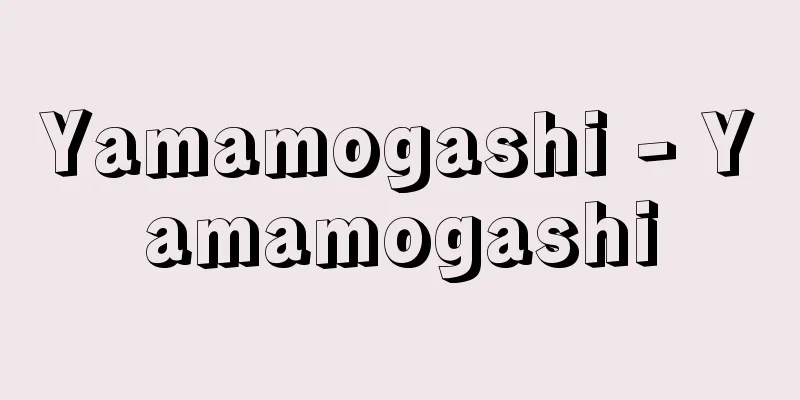City-state (English spelling)

|
A human association or organization in which a city and its territory, although small, constitutes an independent whole as a nation. Walled cities such as Karashar, Kucha, Kashgar, and Turfan, which flourished in the oases in the deserts of inland Asia along the Silk Road since the end of the Han Dynasty, as well as Venice, Florence, Pisa, Milan, and Padua, which flourished in Italy in the late Middle Ages, also belong to the category of city-states in this sense. [Hidemichi Ota] Early city-statesHowever, the city-state, which is the most prominent phenomenon in the entire course of world history, is an organizational entity that was formed when Neolithic villages (based on agriculture and animal husbandry) that were born in the basins of large rivers several thousand years ago further developed to include non-agricultural classes of residents, and became the location of a royal palace or temple, or a royal palace-cum-religious sanctuary, as the center of administration and religion and the rule of complex villages that were at the stage of tribal alliances as a human group. City-states started from this state and took on various political forms in the subsequent development process, but the basic condition for a city-state is that such a human association has a city at its center and a governing mechanism that can be called a state, and the political form is a secondary issue. Therefore, when city-states first appeared in history, they had either a king as the head of a tribal alliance or a high priest of a temple as the center of religion and life. It is assumed that they had a simple structure with a council of elders, a precursor of the noble aristocracy, and a common assembly consisting of ordinary members of the community, as communal institutions, and that slaves and other unfree classes were also growing. The Sumerian city-states of Ur, Uruk, Kish, Lagash, Larsa, and Nippur, which developed in Mesopotamia for several hundred years around 3000 BC, are thought to have been small kingdoms that flourished before the formation of a unified state. The kingdoms of Upper and Lower Egypt, which appeared on the banks of the Nile around 3000 BC, are also thought to have been based on the development of the city-states that preceded them, and that the Indus civilization around 3000 BC and the Chinese civilization before the Yin Dynasty around 1600 BC were also predicated on a certain degree of development of city-states. However, all of these were eventually ruled by or incorporated into the powerful unified kingdom that was established here, and they did not develop any further as city-states. [Hidemichi Ota] City-states of classical antiquityIn contrast, the most typical forms of city-states were developed by the Phoenicians facing the eastern Mediterranean Sea, the Greeks who lived around the Aegean Sea, and the Romans who rose up in Latium in Italy. The Phoenician city-states of Tyre, Sidon, and Byblos, which flourished from around 1000 BC, were conquered by Assyria in the 8th century BC, and subsequently came under the rule of Neo-Babylonia, the Achaemenid Empire of Persia, and Alexander the Great. The Phoenician alphabet, which developed based on Mediterranean trade after the collapse of the Cretan-Mycenaean civilization (around 1200 BC), was adopted by the Greeks in the 8th century BC, and the Greek alphabet, which was the basis of the Latin alphabet that is the basis of today's Roman alphabet, was invented. After the Assyrian conquest, many Phoenician colonies established along the western Mediterranean coast flourished alongside Greek colonies. In particular, Carthage, founded on the north coast of Africa, was an aristocratic state with a powerful army and navy, and served as a defensive base for Phoenician forces in the west, and also came into conflict with Rome, which was rising to power in Italy. However, after the collapse of the Mycenaean civilization, the Greek world expanded around the Aegean Sea, and many city-states (called polis in Greek) were formed around the 8th century BCE. Not only did they experience aristocracy, oligarchy, and tyranny, but they also created democracies based on citizen groups, and throughout the entire process, they showed original and magnificent developments in literature, philosophy, science, art, and crafts, clearly demonstrating the cultural possibilities that the development of city-states can bring to light. The Roman city-states, which began as monarchies, also developed democracy throughout the republican period. Ancient democracy had historical limitations in that it was limited to the mutual relations between active citizens of the city-state, and at its peak, slavery was an essential labor organization not only in the mining and manufacturing sectors but also in agriculture, but it is noteworthy that the core of the citizen groups that made up the people's assemblies were small and medium-sized landowners and self-employed farmers. As long as this citizen class was alive and well, the civic community was healthy, and classical ancient civilization flourished. When the development of commerce and industry, commodity-money relations, and slavery led to the polarization of the civic community, the wealthy citizens sought military dictatorship in order to suppress conflicts between citizens and prepare for foreign enemies, which led to the formation of world empires, and the era of independence of city-states ended after a few hundred years. However, the ancient cities themselves survived even after losing their independence as nations, and did not cease to be the center of ancient civilization for a long time. To judge how close city-states outside of classical antiquity were to those of Greece and Rome, we must determine how close they were to a constitution in which land-owning peasant citizens gathered in a popular assembly to decide the will of the state. [Hidemichi Ota] "Ancient Cities" by Coulanges, translated by Sadanosuke Tanabe (1961, Hakusuisha) " Illustrated World History of Cities 1: Ancient Times" by Leonardo Benevolo, translated by Takahiko Sano and Kanji Hayashi (1983, Sagami Shobo) [Reference] |Source: Shogakukan Encyclopedia Nipponica About Encyclopedia Nipponica Information | Legend |
|
都市とその領域が小規模ながら国家として独立の一全体をなしているような人間の結合体ないし組織体。漢末以来シルク・ロードに沿って内陸アジアの砂漠のなかのオアシスに栄えたカラシャール、クチャ、カシュガル、トゥルファンなどの城郭都市、あるいは中世後半イタリアに栄えたベネチア、フィレンツェ、ピサ、ミラノ、パドバなどもこの意味で都市国家の範疇(はんちゅう)に帰属する。 [太田秀通] 初期の都市国家しかし、世界史の全行程のうえでもっとも顕著な現象としての都市国家は、数千年前の大河の流域などに生まれた新石器時代の村落(農耕、牧畜を基礎とする)がいっそうの発展をして、非農的住民階層をも内包するに至った都市が、人間の集団としては部族連合という段階にある複雑な村落の支配と行政・宗教の中心としての王宮または神殿、または王宮兼宗教的聖所の所在地となった段階の組織体である。都市国家はこのような状態を出発点とし、その後の発展過程でいろいろな政治形態をとるに至ったが、このような人間の結合体が都市を中心として、しかも国家とよびうる支配機構をもつことが都市国家の基礎的条件であり、その政治形態いかんは副次的な問題である。 したがって、初めて都市国家が歴史のうえに出現したときには、部族連合の首長としての王を頂点とするか、宗教と生活の中心としての神殿の大祭司を頂点とした。そして名門貴族の先駆形態としての長老会と共同体の一般成員からなる民会とが共同体的機関として存在するような単純な構造をもち、奴隷をはじめとする不自由身分も成長しつつあったと推測される。紀元前3000年ごろのメソポタミアで数百年にわたって発展したシュメール人のウル、ウルク、キシュ、ラガシュ、ラルサ、ニップールなどの都市国家は、その後ここに統一国家が形成される以前の段階に栄えた小王国であったと考えられる。前3000年ごろナイル河畔に出現した上エジプト王国、下エジプト王国も、これに先行する都市国家の発展を基礎にしていたと考えられるし、前3000年ごろのインダス文明も、前1600年ごろの殷(いん)王朝以前の中国文明も、都市国家の一定の発展を前提としていたと考えられる。しかしこれらはいずれも、やがてここに成立する強大な統一王国に支配されるか編入されるかして、都市国家の形態としてはそれ以上の発展は示さなかった。 [太田秀通] 古典古代の都市国家これに反し、都市国家の形態を典型的に発展させたのは、東地中海に面したフェニキア人、エーゲ海周辺に居住したギリシア人、イタリアのラティウムから興ったローマ人であった。前1000年ごろから栄えたフェニキアのティルス、シドン、ビブロスなどの都市国家は、前8世紀にアッシリアに征服され、その後新バビロニア、アケメネス朝ペルシア、アレクサンドロス大王の支配下に入ったが、クレタ・ミケーネ文明の崩壊(前1200ころ)後の地中海貿易を基礎にして発展したフェニキア文字は前8世紀ギリシア人に採用されて、今日のローマ字の基礎であるラテン・アルファベットのもとであるギリシア文字が発明された。またアッシリアによる征服後、西地中海沿岸につくられた多くのフェニキア人植民市は、ギリシア人の植民市と並んで栄え、ことにアフリカ北岸に建設されたカルタゴは貴族政国家として強力な陸海軍を擁し、西方のフェニキア勢力の防衛拠点となり、またイタリアに台頭したローマと対立するに至った。 しかし、ミケーネ文明崩壊後エーゲ海周辺に拡大されたギリシア世界に、前8世紀ごろ多数形成された都市国家(ギリシア語でポリスとよばれた)は、貴族政、寡頭政、僭主(せんしゅ)政などを経験したばかりでなく、市民団による民主政を生み出し、その全過程を通じて文学、哲学、科学、美術、工芸に独創的なみごとな発展をみせ、都市国家の発展がいかなる文化的可能性を開花させるかを如実に示したといえる。王政から始まったローマ都市国家も共和政期を通じて民主主義を発展させた。古代民主政は都市国家の積極的市民の相互関係だけに限られていたという歴史的限界があり、その最盛時には鉱工業分野だけでなく農業においても奴隷制が不可欠の労働組織であったが、民会を構成する市民団の中心が中小規模の土地所有者、自営農民であったことは注目すべき点である。この市民層が健在である間は市民共同体も健全であり、古典古代文明も栄えていた。商工業の発展と商品貨幣関係および奴隷制の発展が市民共同体を両極分解に導いたとき、市民間抗争を抑え外敵に備えるための必要から富裕市民層は軍事的独裁権を求め、これが世界帝国の形成を促し、都市国家の独立時代も数百年にして終わった。しかし古代都市そのものは国家としての独立を失ったのちも生き残り、長く古代文明の中心であることをやめなかった。古典古代以外の都市国家がどれだけギリシア・ローマのそれに近づいたかを判定するには、土地所有農民たる市民が民会に結集することによって国家の意思を決めるという国制にどの程度近づいていたかを見極めなければならない。 [太田秀通] 『クーランジュ著、田辺貞之助訳『古代都市』(1961・白水社)』▽『レオナルド・ベネーヴォロ著、佐野敬彦・林寛治訳『図説 都市の世界史1 古代』(1983・相模書房)』 [参照項目] |出典 小学館 日本大百科全書(ニッポニカ)日本大百科全書(ニッポニカ)について 情報 | 凡例 |
>>: New Year's Eve - Toshikoshi
Recommend
School report - nashinsho
When applying for admission to a higher level sch...
"The History of the British Industrial Revolution"
…In 1926, he became executive director and later ...
Gothic Confederation - Götiska Förbundet
A Swedish patriotic group. It was founded in Stock...
Guillaume de Conches
Around 1080-1154 An early scholastic philosopher. ...
Land use - Tochiriyo (English spelling) land utilization
Land use is an academic and policy field that exam...
Flacourtia inermis (English name) Flacourtiainermis
…[Sumihiko Hatsushima]. … *Some of the terminolog...
Sayou (English spelling) the left
The origin of the words left wing and right wing c...
Der Stricker
A poet active mainly in Austria in the first half ...
Arai salt - Arai salt
…When Edo first opened, its demand for salt was d...
Front side - Omotekata
A theater term. These people work on the front si...
Golden mosquito - Golden mosquito
… In general, Aedes species have a wide variety o...
Old calligraphy - Kohitsu
In a broad sense, it means handwriting of ancient...
Grand Trianon (English spelling)
…The king's apartments were positioned as the...
Oyama pine tree - Oyama pine tree
She was the youngest daughter of Yamakawa Naoe, a...
One packet - one handful
〘 noun 〙① One package. One package. ※Masukagami (A...









